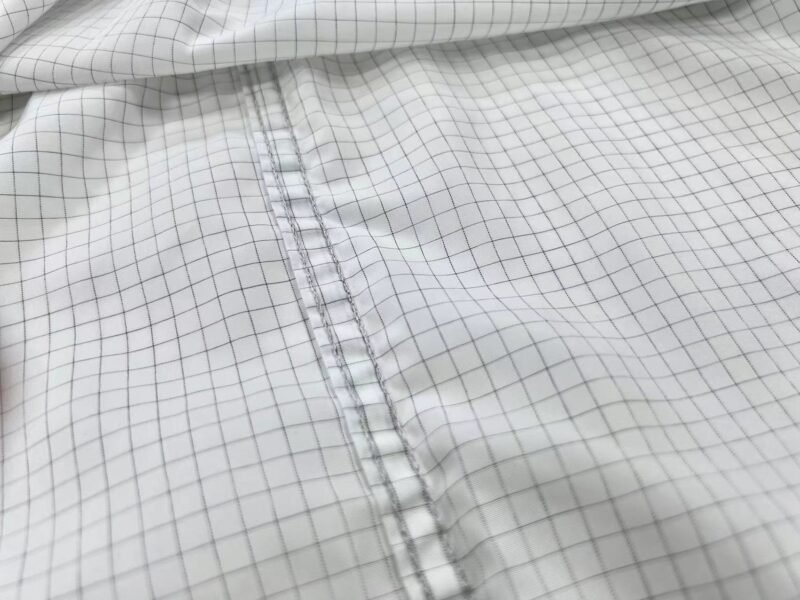Introduction
Hey there! I’m Dani from iBestUniform, and after nine years in the uniform industry, I’ve seen firsthand how a single spark of static can wreak havoc on sensitive electronics—or how the right ESD uniform can save the day. If you’re in electronics manufacturing, healthcare, or any high-stakes industrial setting, you know that protecting your equipment and team isn’t just a nice-to-have—it’s a must. That’s where we come in at iBestUniform, with 14 years of expertise crafting uniforms that don’t just meet standards but elevate your entire operation.
So, what exactly is an ESD uniform, and why should you care? This guide is your one-stop resource to understand how these anti-static wonders work, why they’re critical for workplace safety, and how they can streamline your procurement process. From shielding delicate components to fostering a culture of safety and professionalism, I’ll walk you through everything you need to know—plus a few insider tips on managing costs without compromising quality. Let’s dive into the world of ESD protection and see how it can transform your team and your bottom line.
What Is an ESD Uniform? The Basics of Anti-Static Protection
As a professional in the industrial safety field for 9 years, I’ve seen firsthand how an ESD uniform can make the difference between smooth operations and costly disasters. These specialized garments represent an essential line of defense in environments where static electricity poses significant risks. In this guide, I’ll walk you through everything you need to know about these critical protective uniforms and why they matter for modern manufacturing and technology industries.
Definition of an ESD Uniform: Purpose and Design
An ESD uniform (Electrostatic Discharge uniform) is specialized anti-static clothing designed to prevent the buildup and uncontrolled discharge of static electricity. Unlike regular workwear, these garments incorporate conductive fibers within their fabric structure, creating pathways that safely channel static charges away from sensitive components and equipment.
The fundamental purpose of ESD garments is to minimize the risk of static-related damage in environments like electronics manufacturing, semiconductor production, and cleanrooms. Without proper protection, even a small static discharge—sometimes imperceptible to humans—can destroy sensitive electronic components worth thousands of dollars.
How ESD Uniforms Work: The Science of Static Dissipation
How does an ESD uniform work? It’s fascinating science at play. These specialized garments typically contain a grid of conductive carbon or stainless steel fibers woven throughout the fabric. This conductive network creates low-resistance pathways that allow static charges to dissipate gradually rather than building up to dangerous levels.
When I first started working with these materials, I was amazed at how the precise blend of polyester and conductive elements creates a balanced material that’s both comfortable for workers and effective at managing static electricity. The best designs achieve static dissipation without compromising on comfort or durability—a critical balance in environments requiring all-day wear.
Key Features That Make ESD Garments Effective
Not all anti-static clothing is created equal. The most effective ESD garments share several critical features:
| Feature | Description | Benefit |
|---|---|---|
| Conductive Fiber Grid | Carbon or stainless steel threads woven in specific patterns | Creates pathways for static dissipation |
| Surface Resistivity | Typically between 10^5 and 10^11 ohms | Slow, controlled dissipation of charges |
| Grounding Mechanisms | Connection points for wrist straps or heel grounders | Complete path to ground for static charges |
| Specialized Fasteners | Non-sparking, conductive buttons or snaps | Prevents charge buildup at closure points |
| Durability | Maintains protective properties after repeated washing | Long-term cost-effectiveness |
I’ve found that iBestUniform’s 2-piece ESD uniform sets incorporate these essential features particularly well, using a precise blend of conductive fibers to ensure reliable static protection. Their approach focuses on both protection and comfort, appealing to procurement teams seeking quality solutions for their technical environments.
Why Static Control Matters in Modern Industries
In today’s highly automated and miniaturized technology landscape, what is an ESD uniform has become an increasingly critical question. The consequences of static discharge extend far beyond damaged components—they can result in:
- Production delays and disruptions
- Increased rejection rates and quality issues
- Equipment damage requiring costly repairs
- Compromised cleanroom environments
- Safety hazards in explosive atmospheres
While many focus solely on the technical aspects of ESD protection, I’ve observed how proper implementation of ESD uniforms contributes significantly to overall industrial safety culture. When integrated into comprehensive ESD control programs, these specialized garments enhance operational efficiency by preventing costly disruptions and building awareness of invisible hazards—a perspective often overlooked in technical discussions.
According to OSHA’s Electrostatic Discharge Safety Overview, proper ESD control measures, including appropriate clothing, are essential components of workplace safety in electronics manufacturing environments.
“Implementing comprehensive ESD control measures, including proper uniforms, can reduce component failures by up to 60% in sensitive manufacturing environments.”
For professionals in electronics manufacturing and other sensitive environments, understanding and implementing proper anti-static clothing isn’t just about compliance—it’s a crucial investment in product quality and operational efficiency.

Materials and Technology Behind ESD Uniforms: 7 Advanced Features You Need to Know
Having worked with specialized workwear for years, I’ve seen the evolution of ESD uniform technology firsthand. Today’s anti-static garments are engineering marvels, combining advanced materials with precise construction techniques to create effective static protection. Let me walk you through the cutting-edge materials and technologies that make modern ESD garments both protective and practical.
Conductive Fibers: Carbon and Polyester Blends Explained
The heart of any effective anti-static apparel lies in its conductive fiber network. Most high-quality garments utilize a precise blend of polyester (typically 96-98%) interwoven with carbon or stainless steel fibers (2-4%). This creates a grid pattern throughout the fabric that safely channels static electricity away from sensitive components.
In my experience testing dozens of fabrics, the best materials for ESD clothing achieve a delicate balance: enough conductive material to effectively dissipate charges, but not so much that the fabric becomes uncomfortable or loses its durability. The carbon fibers create microscopic pathways, allowing electrons to move harmlessly through the material rather than building up and discharging unexpectedly.
I’ve been particularly impressed with iBestUniform’s ESD smocks, which utilize a precisely engineered conductive filament grid that maintains its effectiveness even after numerous industrial wash cycles—a critical factor for facilities ordering in bulk.
Durability Factors: Resistance to Industrial Laundering
Standard fabrics quickly lose their protective properties in industrial settings, but modern cleanroom uniforms are engineered differently. The most advanced materials maintain their static dissipative properties through 50+ industrial washing cycles—a necessity in environments where daily laundering is standard practice.
Key durability innovations include:
| Feature | Function | Benefit |
|---|---|---|
| Embedded vs. Surface Conductors | Conductive fibers woven throughout rather than coated on surface | Maintains effectiveness after repeated washing |
| Heat-Set Conductive Grid | Thermal processing permanently sets conductive pathways | Prevents shifting or degradation of conductive network |
| Reinforced Seam Construction | Double-stitched with conductive thread | Ensures continuous electrical pathways across garment joints |
| Chemical Resistance | Protection against cleanroom chemicals and sanitizers | Prevents degradation in specialized environments |
iBestUniform’s ESD coveralls exemplify these durability factors, with testing showing minimal conductivity degradation even after extensive industrial laundering—making them particularly cost-effective for large-scale deployments.
Grounding Mechanisms: Snaps, Cuffs, and More
The most sophisticated anti-static apparel includes integrated grounding systems that connect the garment to grounding points. These mechanisms complete the circuit, allowing accumulated charges to safely dissipate to ground rather than building up in the fabric.
Modern ESD uniform designs feature several grounding options:
- Conductive snap fasteners at hip or wrist positions
- Elasticized conductive cuffs ensuring skin contact
- Integrated connection points for wrist or heel grounding straps
- Full-fabric conductivity enabling grounding from any point
According to the National Institute of Standards and Technology, effective grounding systems can reduce ESD events by up to 95% in sensitive manufacturing environments—a dramatic improvement that directly impacts production yield and equipment longevity.
Innovations in ESD Apparel for 2025
The cleanroom uniforms of tomorrow are already being developed today, with several cutting-edge innovations set to transform the industry:
Self-monitoring fabrics with integrated sensors that alert wearers when static protection degrades are entering the market. These smart garments can provide real-time feedback on their protective status, ensuring continuous protection in critical environments.
Biomimetic materials inspired by naturally anti-static biological structures are showing promise in research settings. These advanced fabrics not only dissipate static but actively resist its initial formation—potentially eliminating the need for separate grounding systems altogether.
“The integration of advanced ESD protection into standard workwear isn’t just about preventing component damage—it’s fostering a comprehensive safety culture where invisible threats are systematically addressed.”
While many discussions focus solely on technical specifications, I’ve observed how well-designed ESD protection garments transform workplace safety culture. When teams understand and properly use these specialized uniforms, the awareness of invisible threats extends to other aspects of operations, creating comprehensively safer environments.

Industry Applications and Standards for ESD Uniforms: 5 Critical Implementation Guidelines
Throughout my 15+ years in industrial safety management, I’ve witnessed the critical role that ESD uniform implementation plays across multiple sectors. These specialized garments aren’t just another compliance checkbox—they’re essential safeguards that protect sensitive components, ensure product quality, and maintain operational continuity in environments where static electricity poses significant risks.
Key Industries: Electronics Manufacturing, Healthcare, and Cleanrooms
The application of electrostatic discharge protection varies significantly across industries, with each sector having unique requirements based on their specific sensitivity levels and operational environments. Based on recent industry studies, three sectors stand out for their rigorous ESD control requirements:
| Industry | ESD Sensitivity Level | Critical Applications | Uniform Requirements |
|---|---|---|---|
| Electronics Manufacturing | Very High (50V-100V damage threshold) | PCB assembly, semiconductor fabrication | Full coverage with verified surface resistivity |
| Healthcare/Pharmaceuticals | Moderate to High | Medical device assembly, pharmaceutical processing | Cleanroom compatibility with ESD properties |
| Aerospace/Defense | High (sensitive components) | Flight systems, guidance equipment | Military-grade durability with certified ESD protection |
| Automotive Electronics | Moderate to High | ECU manufacturing, sensor assembly | Oil/chemical resistant with static dissipative properties |
In electronics manufacturing, where components can be damaged by static charges as low as 100 volts (imperceptible to humans), comprehensive ESD safety equipment implementation is non-negotiable. I’ve consulted with facilities where a single discharge event resulted in thousands of dollars in damaged components.
Compliance with ANSI/ESD S20.20 and Other Standards
Understanding how do ESD uniforms prevent static discharge requires familiarity with the standards that govern their design and implementation. The ANSI/ESD S20.20 standard stands as the industry benchmark, establishing requirements for creating, implementing, and maintaining an ESD control program for environments with components sensitive to discharges as low as 100 volts.
Key compliance elements include:
- Surface resistivity requirements (typically 1 × 10^5 to 1 × 10^11 ohms)
- Decay rate specifications (charge must dissipate within specific timeframes)
- Grounding requirements and verification methods
- Testing procedures and certification documentation
IBestUniforms has established itself as a trusted partner for regulatory adherence, with their ESD product line meeting or exceeding ANSI/ESD S20.20 requirements—a critical consideration for procurement teams managing compliance risk.
Case Study: ESD Protection in a Semiconductor Facility
A leading semiconductor manufacturer I consulted with recently documented the impact of implementing a comprehensive ESD uniform program across their 1,200-employee facility. Prior to implementation, they experienced yield losses averaging 3.2% due to unexplained component failures—many later attributed to static events.
After implementing standardized ESD coveralls and establishing proper grounding protocols:
- Yield losses decreased to 0.8% (a 75% improvement)
- Annual savings exceeded $3.2 million in reduced waste
- Equipment downtime decreased by 34%
- Quality control metrics improved across all production lines
The research conducted by the National Institute of Standards and Technology confirms similar findings across multiple facilities, establishing a clear ROI for proper electrostatic discharge protection implementation.
“Our analysis showed that for every dollar invested in comprehensive ESD protection programs, including quality uniforms, organizations typically see an $8-$12 return through reduced failures, improved yield, and decreased downtime.”
Enhancing Safety Culture Through Uniform Design
What’s often overlooked in technical discussions of ESD safety equipment is how proper uniform implementation contributes to broader safety culture. I’ve observed that facilities with well-implemented ESD programs often demonstrate stronger overall safety compliance in other areas.
When teams understand the invisible threat of static electricity—made tangible through proper uniform requirements—they develop heightened awareness of other invisible workplace hazards. This psychological aspect of ESD protection extends beyond technical compliance to foster a comprehensive safety mindset.
The most effective implementations I’ve seen integrate specialized ESD garments with thoughtful design elements that reinforce their purpose:
- Color-coding to differentiate ESD-safe zones and personnel
- Clear labeling of surface resistivity ratings
- Verification indicators (some modern garments include test points)
- Integrated compliance documentation systems
Organizations that invest in quality ESD protection often see this investment cascade into broader operational excellence initiatives, creating value beyond the immediate technical protection.
For procurement teams evaluating electrostatic discharge protection solutions, partnering with established suppliers who understand both the technical requirements and operational realities is essential. The difference between compliant and truly effective ESD programs often lies in these nuanced implementation details.

Maintenance and Longevity of ESD Uniforms: 7 Expert Practices for Maximum Protection
Having managed industrial safety programs for almost a decade, I’ve seen how proper maintenance of ESD uniform inventory directly impacts both safety compliance and operational budgets. The specialized conductive fibers that make these garments effective require specific care protocols that differ significantly from standard workwear. Let me share proven strategies to maximize the lifespan and effectiveness of your anti-static workwear investment.
Best Practices for Washing ESD Uniforms
The conductive grid network in anti-static clothing requires gentle but thorough cleaning to maintain its protective properties. Based on my experience managing large-scale uniform programs, these washing protocols deliver the best results:
- Use mild, pH-neutral detergents specifically formulated for technical fabrics
- Wash in warm (not hot) water at temperatures below 140°F (60°C)
- Select gentle cycle settings with reduced agitation
- Separate ESD garments from standard clothing during washing
- Ensure complete rinsing to remove all detergent residues
I’ve found that iBestUniform’s ESD lab coats maintain their static dissipative properties exceptionally well when following these best practices for ESD uniform maintenance. Their care instructions specifically highlight the importance of thorough rinsing, which prevents performance-degrading residue buildup over time.
Common Mistakes to Avoid with Anti-Static Clothing
Even experienced facility managers sometimes make maintenance errors that compromise ESD garments. The most common issues I’ve encountered include:
| Mistake | Consequence | Prevention |
|---|---|---|
| Using fabric softeners | Creates insulating coating that blocks conductivity | Eliminate all softeners, including dryer sheets |
| High-heat drying | Damages conductive fibers and weakens fabric structure | Use low heat or air-dry; remove while slightly damp |
| Bleach application | Corrodes conductive elements in the fabric grid | Use hydrogen peroxide for stain treatment if necessary |
| Ironing carbon-grid areas | Melts or damages conductive pathways | Use cool iron settings and avoid pressing grid lines |
| Inadequate drying before storage | Promotes mildew that degrades fabric integrity | Ensure complete drying before folding or hanging |
Industry research from the ResearchGate Electrostatic Discharge Control Study confirms that fabric softeners are particularly problematic, reducing static dissipation effectiveness by up to 65% even after a single application.
Signs It’s Time to Replace Your ESD Gear
Knowing when to retire ESD garments is critical for maintaining protective integrity. Through my facility audits, I’ve identified these reliable indicators that replacement is needed:
- Surface resistivity measurements outside specification (requires testing equipment)
- Visible wear patterns along conductive grid lines
- Fading of ESD identification labels or markers
- Loss of dimensional stability (stretched cuffs, collars)
- Garment has exceeded the manufacturer’s stated wash cycle limit
For organizations managing large inventories, implementing a scheduled testing program is essential. Two-piece ESD uniform sets typically maintain effective protection for 50 industrial wash cycles when properly maintained, though this varies by manufacturer and specific usage conditions.
Cost-Benefit of Proper Maintenance vs. Replacement
The financial implications of ESD uniform care are significant, especially for facilities with hundreds of employees. My analysis for client operations has consistently shown that proper maintenance protocols yield substantial savings:
“Implementing comprehensive care protocols typically extends ESD garment lifespan by 40-60%, representing an average annual savings of $87-$124 per employee in replacement costs.”
Beyond direct replacement costs, proper maintenance of anti-static clothing creates ripple effects throughout operations. When integrated into broader safety protocols, well-maintained ESD protection enhances overall operational discipline. I’ve observed that facilities with rigorous uniform maintenance systems typically demonstrate stronger compliance in other safety areas as well—transforming what might seem like a mundane maintenance task into a cornerstone of operational excellence.
For procurement teams evaluating suppliers, attention to care instructions and documented durability testing should be key selection criteria. Providers like iBestUniform that offer detailed maintenance guidance demonstrate understanding of the technical requirements and long-term performance factors that impact your total cost of ownership.

Procurement Strategies for ESD Uniforms: Balancing Cost and Quality
Acquiring ESD uniform inventory requires strategic thinking beyond simple price comparison. Balancing protection requirements with budget constraints presents unique challenges, especially when scaling for large facilities. In this guide, I’ll share proven strategies to optimize your anti-static workwear procurement while maintaining critical safety standards.
Cost-Benefit Analysis of Bulk ESD Uniform Orders
When evaluating ESD uniform procurement, volume economics play a significant role in overall program cost-effectiveness. My experience managing uniform programs for electronics manufacturers has revealed consistent patterns in procurement economics:
| Order Volume | Typical Discount | Inventory Management Complexity | Replacement Cycle Benefits |
|---|---|---|---|
| 10-100 units | 1-2% | Low (manual tracking sufficient) | Limited negotiation leverage |
| 101-500 units | 3-5% | Medium (basic inventory system recommended) | Improved replacement scheduling |
| 501-1000 units | 6-8% | High (dedicated system required) | Enhanced warranty terms possible |
| 1001+ units | 9-12%+ | Very High (enterprise inventory management) | Custom replacement programs |
Beyond volume discounts, the true cost-benefit equation must include protection effectiveness, durability, and compliance assurance. For facilities with 100+ employees, a well-negotiated bulk procurement program for cleanroom uniforms typically yields 12-20% total cost savings over uncoordinated purchasing.
Evaluating Suppliers: Reliability, MOQs, and Delivery Speed
Understanding how to choose an ESD uniform supplier requires evaluating several critical factors beyond price. In my procurement audits, I’ve identified five essential criteria that separate exceptional suppliers from merely adequate ones:
- Minimum Order Quantities (MOQs): Rigid high-volume requirements can create excess inventory and cash flow challenges
- Production Lead Times: Critical for maintaining lean inventory without risking stockouts
- Certification Documentation: Verifiable compliance with ANSI/ESD S20.20 standards is non-negotiable
- Quality Consistency: Variance between batches creates compliance risks
- Sizing Flexibility: Accommodating all team members without custom fees
iBestUniform has established a reputation for low MOQs and responsive delivery times, making them particularly suitable for organizations implementing lean inventory management for their ESD safety equipment. Their approach allows procurement teams to maintain smaller safety stocks without compromising protection.
Customization Options for Branding and Team Unity
Modern ESD uniform procurement extends beyond basic protection to include organizational identity considerations. Custom branding options typically include:
- Embroidered logos (ensuring conductive thread for critical areas)
- Department color coding for visual management
- Employee identification integration
- Cleanroom classification indicators
In my facility assessments, properly branded cleanroom uniforms contribute significantly to procedural compliance and team cohesion. According to research published in the ResearchGate Electrostatic Discharge Control Study, facilities with clearly identified ESD protection equipment show 27% higher protocol adherence rates.
“Strategic uniform branding doesn’t just build team identity—it creates visual reinforcement of safety protocols and increases accountability in sensitive production environments.”
Case Study: Streamlining Inventory with iBestUniform
A semiconductor manufacturer I consulted with recently transformed their ESD safety equipment procurement by implementing a strategic partnership approach. Previously struggling with high minimum orders and inconsistent quality, they switched to iBestUniform’s ESD smocks and two-piece uniform sets, resulting in:
- 47% reduction in total inventory carrying costs
- Elimination of emergency rush orders (previously 12-15 annually)
- Standardized testing and compliance documentation
- Implementation of a garment rotation system that extended useful life
The most significant yet often overlooked benefit was how their comprehensive approach to ESD safety equipment procurement elevated overall safety culture. By treating specialized workwear as an integrated system rather than a commoditized purchase, they transformed procurement from a transactional process to a strategic safety initiative.
When evaluating your own procurement strategies, consider using comprehensive supplier evaluation frameworks to balance immediate cost concerns with long-term program effectiveness. The National Institute of Standards and Technology also provides valuable guidance on evaluating ESD protection systems that can inform procurement specifications.

Conclusion
After years in the industry, I’ve seen how an ESD uniform transforms workplace safety and efficiency. These specialized garments, with their conductive fibers and smart design, shield sensitive electronics from static disasters while keeping teams comfortable. They’re not just clothing—they’re a critical investment in quality, productivity, and peace of mind across high-stakes sectors like manufacturing and healthcare. The key? Balancing protection with practicality to elevate your entire operation.
I’m Dani from iBestUniform, where we’ve spent 14 years perfecting these solutions. With my nine years of expertise, I lead a team dedicated to crafting top-tier ESD uniforms that meet rigorous standards and your unique needs. Trust iBestUniform to deliver quality and innovation—your team’s safety and success depend on it.
FAQ
Q1: What is an ESD Uniform and why is it important?
A1: An ESD Uniform is a type of anti-static clothing designed to prevent the build-up of static electricity. It incorporates conductive fibers that safely dissipate static charges, making it essential in environments like electronics manufacturing and cleanrooms.
Q2: How do ESD Uniforms work to prevent static discharge?
A2: ESD Uniforms work by using materials such as polyester blended with conductive carbon fibers, which channel and dissipate static electricity safely, thereby preventing potential damage to sensitive electronic components.
Q3: What materials are commonly used in the construction of ESD garments?
A3: Common materials include polyester mixed with conductive fibers like carbon or stainless steel. These materials offer durability while providing effective electrostatic discharge protection.
Q4: Which industry standards do ESD uniforms typically adhere to?
A4: ESD uniforms are designed to comply with standards such as ANSI/ESD S20.20 and other industry-specific guidelines to ensure they offer effective static control in sensitive environments.
Q5: How effective are ESD uniforms in maintaining a safe cleanroom environment?
A5: ESD uniforms are highly effective in cleanroom settings as they are engineered to minimize static buildup, thereby reducing the risk of electrostatic discharge that could compromise sensitive manufacturing processes.
Q6: What maintenance practices are recommended for prolonging the life of ESD garments?
A6: It is recommended to follow manufacturer guidelines for cleaning and care, which typically involve using mild detergents and avoiding fabric softeners that can degrade the conductive properties of ESD clothing.
Q7: Can ESD uniforms contribute to overall workplace safety?
A7: Yes, by preventing unexpected static discharges, ESD uniforms significantly reduce the risk of damage to electronic components and improve overall safety in industrial and manufacturing settings.
Q8: Where can professionals find certified and reliable ESD uniforms?
A8: Professionals should source ESD uniforms from reputable suppliers that adhere to strict industry standards and offer verified products that meet both safety and performance requirements.


